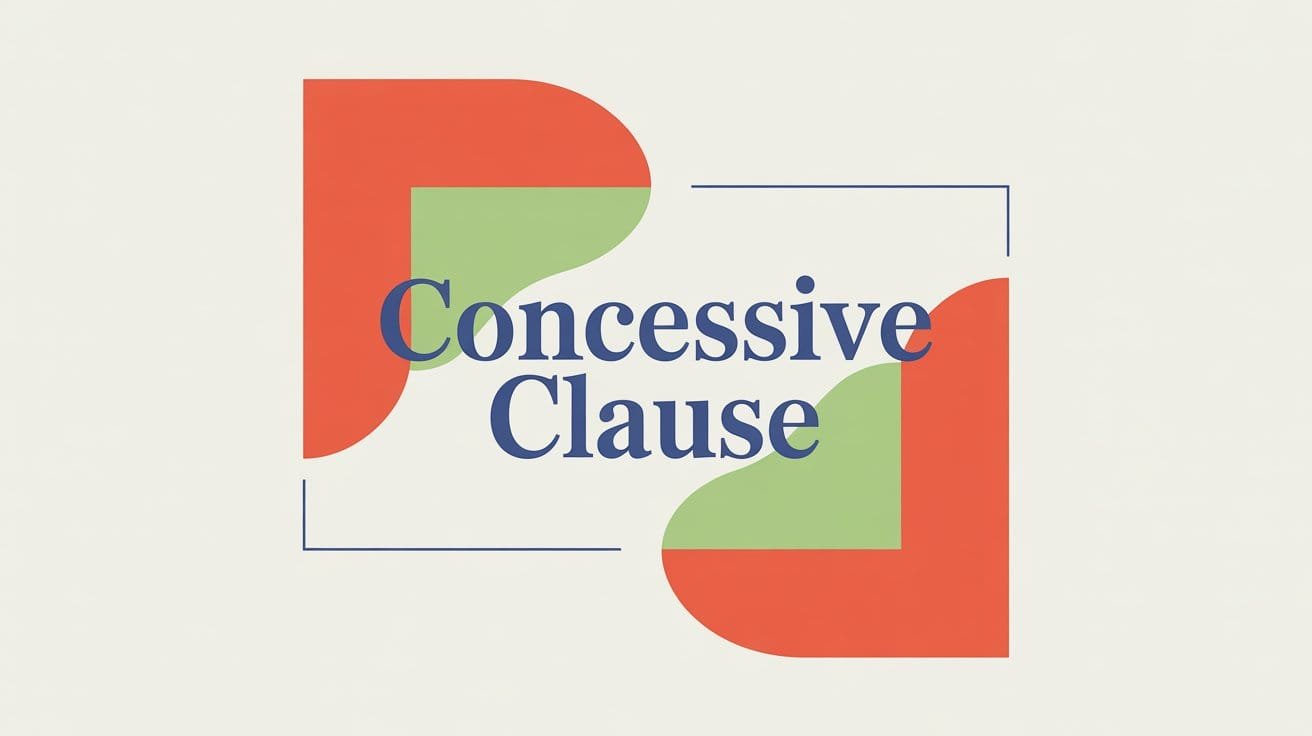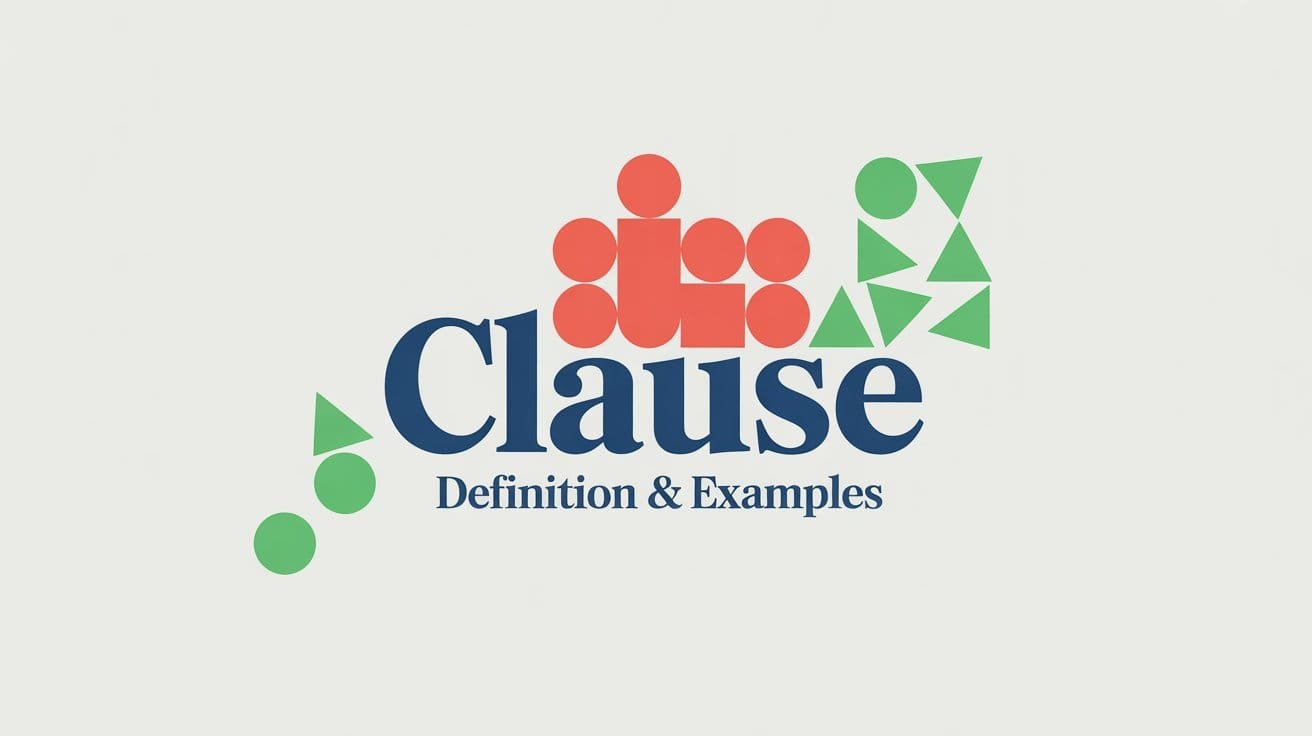A concessive clause is a type of subordinate clause that shows a contrast between two ideas. It introduces a condition or situation that seems to go against the result in the main clause, often using conjunctions like although, even though, or while.
In this article, you’ll learn what concessive clauses are, how to recognize and use them, and how they differ from similar phrases—all with examples for better understanding.
What Is a Concessive Clause?
A concessive clause is a dependent clause that contrasts with the main clause by introducing an idea that seems to contradict or challenge it. It sets up a situation where something happens despite another fact or condition.
These clauses are introduced by subordinating conjunctions such as although, even though, though, while, and whereas. Because they are dependent, they cannot stand alone and must be connected to an independent clause.
Concessive Clause Examples:
- Although the team was tired, they kept playing.
(Contrast: They were tired, yet they continued) - She finished the race even though she had an injury.
(The injury didn’t stop her, which is unexpected) - While he disagrees with the plan, he agreed to support it.
(The contrast is between disagreement and cooperation)
Concessive clauses add complexity and nuance by showing that one idea doesn’t cancel or stop another, even when it might be expected to.
Identifying Concessive Clauses
To identify a concessive clause, look for a group of words that:
- Begins with a subordinating conjunction showing contrast
- Contains a subject and a verb
- Is connected to a main clause and cannot stand alone
- Expresses an idea that contrasts with or challenges the main idea
Common Subordinating Conjunctions for Concessive Clauses:
- although
- even though
- though
- while
- whereas
These words signal that something unexpected is being introduced.
Examples:
- Even though it was late, they continued the meeting.
(Concessive clause = Even though it was late; main clause = they continued the meeting) - She stayed calm although the situation was tense.
(The clause adds contrast: a tense situation, but she remained calm) - Whereas his brother is outgoing, he prefers quiet environments.
(Shows contrast between two people)
To confirm it’s a concessive clause, ask: Does this part of the sentence present a surprising or opposing idea compared to the main clause? If yes—and it includes a subject and verb—it’s likely a concession.
Structure of Concessive Clauses
A concessive clause follows the basic structure of a dependent clause: it contains a subject and a verb and begins with a subordinating conjunction. It cannot stand alone and must be linked to an independent (main) clause.
Common Sentence Patterns
Concessive Clause + Main Clause
- Although it was snowing, the buses kept running.
- Even though he disagreed, he respected the decision.
Main Clause + Concessive Clause
- They went ahead with the plan even though some members hesitated.
- She applied for the job although she lacked experience.
The meaning remains the same in both orders, but when the concessive clause comes first, it’s followed by a comma. When it comes after the main clause, a comma is usually not needed unless for emphasis or clarity.
Important Note:
Don’t confuse concessive clauses with conditional or causal clauses. Concessive clauses always show unexpected contrast, not cause or condition.
Concessive Clauses vs. Concessive Phrases
Both concessive clauses and concessive phrases express contrast, but differ in structure.
A concessive clause contains a subject and a verb and begins with a subordinating conjunction such as although, even though, or while. It forms a full dependent clause.
A concessive phrase, on the other hand, does not have a subject-verb combination. It’s often introduced by prepositions like despite or in spite of, followed by a noun or a gerund.
Examples:
Concessive Clause:
- Although he was tired, he kept working.
(Subject = he, Verb = was)
Concessive Phrase:
- Despite his tiredness, he kept working.
(No subject-verb structure; his tiredness is a noun phrase)
Another example:
Clause: Even though the weather was bad, they held the event.
Phrase: In spite of the bad weather, they held the event.
Quick Tip:
If it has a subject and a verb, it’s a clause. If it has only a noun or noun-like structure, it’s a phrase.
Punctuation Rules for Concessive Clauses
Punctuation in concessive clauses depends on where the clause appears in the sentence. Using commas correctly helps prevent confusion and keeps your writing smooth.
When the Concessive Clause Comes First
If the concessive clause appears at the beginning of the sentence, it should be followed by a comma.
Examples:
- Although the road was closed, we found another route.
- Even though he arrived late, the team welcomed him.
The comma sets the clause apart and signals the reader to pause before the main idea.
When the Concessive Clause Comes After
If the concessive clause comes after the main clause, a comma is usually not needed.
Examples:
- He stayed quiet although he disagreed with the decision.
- They moved forward with the project even though the budget was cut.
However, a comma may be used for emphasis or clarity in longer sentences.
Avoiding Overuse of Commas
Don’t insert a comma between the subject and the verb in the middle of a concessive clause. Also, avoid using two commas unless the clause is nonessential, which concessive clauses typically are not.
FAQs About Concessive Clauses
What is a concessive clause in English grammar?
A concessive clause is a dependent clause that expresses contrast or unexpected results. It shows that something happens even though another factor might suggest otherwise. It often begins with although, even though, though, while, or whereas.
Can a concessive clause start a sentence?
Yes. When it does, it should be followed by a comma. For example- Although the forecast warned of rain, the event was not canceled.
Is there a difference between a concessive clause and a concessive phrase?
Yes. A concessive clause includes a subject and a verb. A concessive phrase does not—it typically starts with a preposition like despite or in spite of followed by a noun or gerund. Both express contrast, but their structures are different.
Do I always need to use a comma with a concessive clause?
Use a comma when the concessive clause comes before the main clause. When it comes after, a comma is usually not necessary unless it helps with clarity or emphasis.



